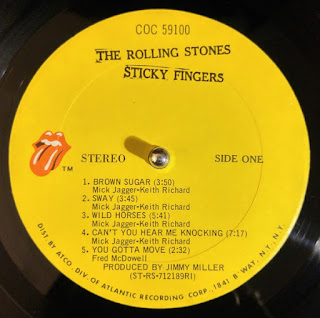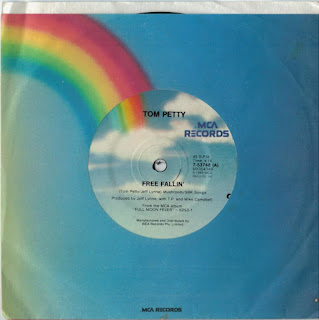Publicada: 23 d’abril de 1971
Àlbum: Sticky Fingers
"Can't You Hear Me Knocking" és una cançó destacada de l'àlbum dels Rolling Stones de 1971 "Sticky Fingers". Amb més de set minuts de durada, la cançó presenta una memorable introducció de guitarra de Keith Richards. La part principal dura dos minuts i 43 segons abans de passar a una llarga improvisació. A més de la formació principal dels Rolling Stones amb Mick Jagger, Keith Richards, Mick Taylor, Charlie Watts i Bill Wyman, la pista compta amb les contribucions del percussionista Rocky Dijon, el saxofonista Bobby Keys, l'organista Billy Preston i percussió addicional del productor Jimmy Miller.
A "Can't You Hear Me Knocking", l'habilitat amb la guitarra de Mick Taylor brilla amb força. El seu estil elegant i poderós afegix una qualitat lírica a la cançó, mostrant la seva excepcional oïda per a la música. La pista destaca com l'extravagança de guitarra més gran dels Rolling Stones, barrejant el so brut amb el so excels de la guitarra de Taylor. "Can't You Hear Me Knocking" destaca com un extrany moment de llarga improvisació en una banda coneguda per les seves composicions concises.
La cançó comença amb una base elemental de blues rock, ancorada per l'icònic riff de Keith Richards i un ritme funky de Charlie Watts i Bill Wyman, però és la secció instrumental llarga del final el que realment destaca de la pista. Aquesta secció, que comença al voltant del minut 2:40, va ser una creació espontània. La banda inicialment pensava que la cançó havia acabat, però el desig de Mick Taylor de continuar tocant va portar a una sessió d'improvisació. La cinta encara estava gravant, capturant la màgia del moment en una sola presa.
Durant aquesta secció instrumental, les línies fluides de guitarra de Taylor, influïdes per la música llatina, es creuen amb els trets staccato de Richards, creant un paisatge musical fascinant. El saxofonista Bobby Keys contribueix amb un solo de blues gemegant, afegint més ànima a l'arranjament. Mick Jagger més tard va elogiar l'estil de tocar melòdic de Taylor, destacant-lo com el responsable de proporcionar la inspiració per a la resta de la banda durant la sessió d'enregistrament.
"Can't You Hear Me Knocking" és una d'aquelles pistes dels Rolling Stones on la lletra podria no tenir un significat trascendent. De fet, el mateix Mick Jagger no està del tot segur del que va escriure. Segons el llibre de Robert Greenfield, "Ain't It Time We Said Goodbye", hi va haver una reunió per transcriure la lletra abans del llançament de l'àlbum per assegurar-ne els drets d'autor. Desafortunadament, algunes frases es van malinterpretar o oblidar, portant an errors divertits com "I've got flatted feet, now" (Tinc els peus plans, ara). Jagger va negar haver escrit aquesta frase però no va poder recordar la correcta, així que es va mantenir a la cançó. Malgrat l'ambigüitat de la lletra, la cançó conté referències evidents a les drogues, com "cocaine eyes" and "speed-freak jive" (ulls de cocaïna i jerga de velocitat). Aquestes referències reflecteixen la cultura de la droga prevalent entre la banda i els seus associats en aquell moment.
ROLLING STONES - CAN’T YOU HEAR ME KNOCKING
Released: April 23, 1971
Album: Sticky Fingers
"Can't You Hear Me Knocking" is a standout track from the Rolling Stones' 1971 album “Sticky Fingers”. Clocking in at over seven minutes, the song features a memorable guitar intro by Keith Richards. The main part of the song lasts for about two minutes and 43 seconds before transitioning into an extended improvisational jam. In addition to the core Rolling Stones lineup of Mick Jagger, Keith Richards, Mick Taylor, Charlie Watts, and Bill Wyman, the track features contributions from conga player Rocky Dijon, saxophonist Bobby Keys, organist Billy Preston, and additional percussion by producer Jimmy Miller.
In "Can't You Hear Me Knocking," Mick Taylor's guitar prowess shines brightly. His elegant and powerful playing style adds a lyrical quality to the song, showcasing his exceptional ear for music. The track serves as the Rolling Stones' greatest guitar extravaganza, blending brutality with a wide-open sound. It stands out as a rare moment of long-form jamming from a band known for concise compositions.
The song begins with an elemental blues rocker foundation, anchored by Keith Richards' iconic riff and a funky groove from Charlie Watts and Bill Wyman, but it's the extended instrumental section that truly elevates the track. This section, which kicks in around the 2:40 mark, was a spontaneous creation. The band initially thought the song was over, but Taylor's desire to continue playing led to an impromptu jam session. The tape was still rolling, capturing the magic of the moment in one take.
During this extended section, Taylor's fluid guitar lines, influenced by Latin music, intertwine with Richards' staccato shots, creating a mesmerizing musical landscape. Saxophonist Bobby Keys contributes a blues-wailing solo, adding further depth to the arrangement. Mick Jagger later praised Taylor's melodic playing style, emphasizing how it provided inspiration and direction for the rest of the band during the recording session.
"Can't You Hear Me Knocking" is one of those Rolling Stones tracks where the lyrics might not hold a deeper meaning. In fact, Mick Jagger himself isn't entirely sure of what he wrote. According to Robert Greenfield's book, Ain't It Time We Said Goodbye, there was a rush to transcribe the lyrics before the album's release to secure copyright. Unfortunately, some lines were misheard or forgotten, leading to amusing mistakes like "I've got flatted feet, now." Jagger denied writing that line but couldn't recall the correct one, so it remained in the song. Despite the lyrical ambiguity, the song does contain evident drug references, such as "cocaine eyes" and "speed-freak jive." These references reflect the drug culture prevalent among the band and their associates at the time.














































